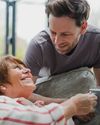The Science Of Regenerative Medicine Has Not Caught Up With The Hype, But This Burgeoning Field Shows Potential For Pain Relief.

IT SEEMS EVERYONE HAS A DIFFERENT IDEA ABOUT REGENERATIVE MEDICINE – what it is, what it does, whom it helps. Many in the public believe it’s a way to stay younger longer. For research scientists like Jeffrey Lotz, Jennifer Elisseeff and Farshid Guilak, it’s the key to developing novel ways to repair and replace damaged joint tissue. And for orthopedic surgeon Riley Williams III, MD, it’s important because it can help patients stay active. That’s crucial, he says, because “longevity and health are largely associated with exercise.”
Regenerative medicine is an umbrella term for a rapidly evolving branch of medicine that uses interventions like stem cells and tissue engineering procedures to “fix” tissues and organs that have failed to repair themselves or recover from injury. All are based on the idea, backed by existing evidence, that the body can repair itself. It’s easy to see the appeal. Many chronic ailments have no real cure – although there may be effective treatments to tame symptoms – and the cost and side effects of drug therapies can be deterrents. That leaves many people looking for other options.
But expectations for regenerative medicine have sometimes gotten ahead of the science. Although its potential to repair and rebuild arthritis-damaged joints has not been fulfilled yet, it has had successes, especially for pain relief and functional improvements. And because the field, which has been largely unregulated, is booming, it’s attracted the attention of the Food and Drug Administration, which has recently issued guidance to help ensure patient safety.
Dr. Williams, who directs the Institute for Cartilage Repair at the Hospital for Special Surgery (HSS) in New York City, says it’s important to separate what goes on in reputable research institutions from certain for-profit clinics that hawk therapies of questionable value.
Diese Geschichte stammt aus der Winter 2018-2019-Ausgabe von Arthritis Today.
Starten Sie Ihre 7-tägige kostenlose Testversion von Magzter GOLD, um auf Tausende kuratierte Premium-Storys sowie über 8.000 Zeitschriften und Zeitungen zuzugreifen.
Bereits Abonnent ? Anmelden
Diese Geschichte stammt aus der Winter 2018-2019-Ausgabe von Arthritis Today.
Starten Sie Ihre 7-tägige kostenlose Testversion von Magzter GOLD, um auf Tausende kuratierte Premium-Storys sowie über 8.000 Zeitschriften und Zeitungen zuzugreifen.
Bereits Abonnent? Anmelden

11 Ways to Build Resilience
Discover ways to overcome adversity and put a positive spin on any setback.

Why Timing Matters
CIRCADIAN RHYTHM MAY INFLUENCE DRUGS’ EFFECTIVENESS.

THE ENEMY WITHIN
UNCONTROLLED INFLAMMATION UNDERLIES MANY CONDITIONS COMMON IN PEOPLE WITH ARTHRITIS. LEARN HOW TO TAMP IT DOWN.

Power of Positivity
POP STAR PAULA ABDUL’S JOYFUL OUTLOOK KEEPS HER DANCING PAST THE PAIN.

Men Who Care
MORE MEN ARE TAKING ON THE TOUGH JOB OF CAREGIVING.

How to Pick the Right Mattress
IT CAN MAKE A DIFFERENCE FOR YOUR SLEEP AND YOUR PAIN.

A Doctor's Advice
FOR DR. TRAVIS STORK, A SIMPLE TOE INJURY LED TO ARTHRITIS AND BACK SURGERY.

GOOD (FOR YOU) DEEDS
HOW HELPING OTHERS HELPS YOU.

Eating to Ease Gout
WATCHING WHAT YOU EAT MAY REDUCE FLARES – UP TO A POINT.

Bad Isn't Always A Catastrophe
EXAGGERATED FEARS MAY HEIGHTEN PAIN.